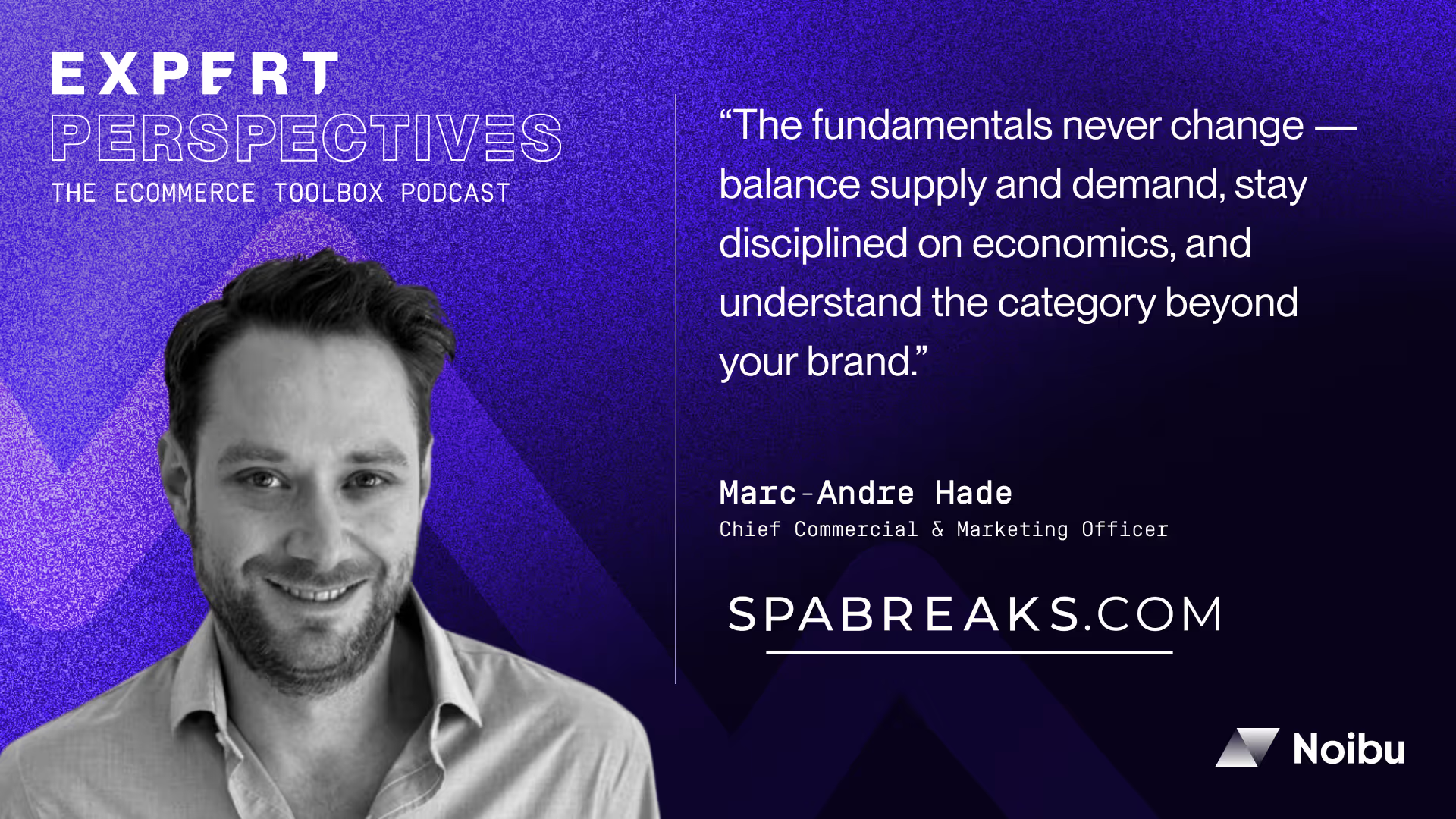From marketplace strategy to SpaBreaks’ digital success: Insights from Marc-André Hade
.avif)
Get the full episode here
Published by Noibu | The Ecommerce Toolbox: Expert Perspectives
Guest: Marc-André Hade, Chief Commercial & Marketing Officer at SpaBreaks
Host: Kailin Noivo, Co-Founder at Noibu
🎧 Listen to the full conversation on Apple, Spotify, or YouTube
The strategic question for every marketplace leader
When your company already leads its category, what actually drives the next stage of growth?
For Marc-André Hade, Chief Commercial & Marketing Officer at SpaBreaks.com, the answer wasn’t “more ads” or “more channels.” It was discipline — aligning every lever of growth around one shared system: supply availability, conversion health, and full-funnel marketing performance.
SpaBreaks.com is now the UK’s largest spa marketplace, having evolved from a call-center operation into a 90%-online business. The growth story isn’t about digital transformation alone — it’s about how Hade built a marketplace playbook that applies to any ecommerce leader managing complexity, category creation, and scale.
“The fundamentals never change — balance supply and demand, stay disciplined on economics, and understand the category beyond your brand.”
— Marc-André Hade, Chief Commercial & Marketing Officer at SpaBreak

1. Marketplaces don’t win on demand — they win on availability
Every ecommerce executive obsesses over traffic. Fewer talk about availability — and that’s the blind spot that caps growth.
When Hade joined SpaBreaks, supply was already deep: 500+ spa partners, healthy penetration, and strong coverage. But the growth unlock wasn’t more partners — it was better inventory readiness.
“It’s always availability, availability, availability. You can’t capture demand that can’t transact.”
— Marc-André Hade, Chief Commercial & Marketing Officer at SpaBreak
For ecommerce operators, this translates to:
- Audit real-time stock and bookability, not just total listings.
- Integrate upstream systems (APIs, reservation managers, feed updates) so your product truly is available when users browse.
- Build dynamic pricing or packages that create elasticity when demand shifts.
Availability doesn’t sound sexy — but it’s where marketplaces silently win.
2. Align your revenue engine: brand + performance + commercial
Most ecommerce orgs are structured in silos: brand marketing builds awareness, performance marketing drives ROAS, and commercial teams own conversion or margin.
Hade merged them.
“I have all the growth levers under my scope — marketing and commercial. It forces alignment. One vision, shared KPIs.”
— Marc-André Hade, Chief Commercial & Marketing Officer at SpaBreak
The payoff: SpaBreaks’ “venue-funded sales” campaigns — three annual marketing pushes where 25–35% of spa partners offer special packages, paired with upper-funnel brand investment. The result is a double flywheel:
- Upper funnel builds category awareness.
- Partner-funded offers drive immediate conversion.
- ROAS improves both short and long term.
For leaders, this is the new full-funnel model: brand is the accelerator; performance is the steering wheel. If you separate them, you’ll forever fight between “storytelling” and “sales.”
3. Measure discipline, not just growth
Marc-André’s career — at eBay, TheFork, and now SpaBreaks — is a masterclass in disciplined growth. His north star metric? LTV:CAC.
In a category where customers might only book a few times a year, SpaBreaks still ensures profitability on first order. Loyalty programs (7% cashback on the second booking) are designed not to chase vanity retention, but to cross the 1→2 booking threshold that predicts long-term value.
For senior operators, that’s the takeaway:
- Design retention levers that have economic logic, not just engagement appeal.
- Know which transaction triggers LTV acceleration.
- Treat loyalty as a profitability tool, not a CRM campaign.
4. Expand your category by lowering perception barriers
When growth flattens, most brands double down on acquisition. SpaBreaks went the other way — they grew by expanding the definition of the market itself.
The insight: spa breaks were perceived as a “luxury,” not an accessible form of wellness. Hade’s team reframed the category through campaigns like “Spa Days Under £100”, inclusive imagery, and educational content around cancer-safe and menopause-friendly treatments.
“We’re democratizing wellness — showing that self-care isn’t an indulgence, it’s for everybody.”
— Marc-André Hade, Chief Commercial & Marketing Officer at SpaBreak
.avif)
This isn’t just purpose-driven marketing; it’s category engineering. By broadening relevance, SpaBreaks didn’t just steal share — they grew the pie.
For executives, the takeaway is simple:
You don’t grow categories by adding SKUs. You grow them by removing psychological friction.
5. The data stack behind sustainable growth
Behind SpaBreaks’ conversion gains (+35% YoY) sits operational detail: API integrations with partner systems, automated availability updates, and constant site optimization.
But what stands out is how the team prioritizes data: not vanity dashboards, but a few high-impact metrics that connect the funnel:
- Blended CAC (brand + performance combined)
- Cohort-based LTV (by acquisition source)
- Conversion efficiency (site + checkout)
It’s not the volume of data — it’s the discipline of interpretation. Hade’s team doesn’t chase “attribution purity”; they chase directional clarity that lets brand and finance speak the same language.
“The gold standard for reporting isn’t marketing — it’s finance. You need to speak their language.”
— Marc-André Hade, Chief Commercial & Marketing Officer at SpaBreak
6. The next macro shifts every ecommerce leader should watch
Hade closed with a sober assessment of what’s ahead:
- AI is changing discovery faster than SEO can adapt. LLMs and chat assistants will cut organic traffic for many categories. Brands must own demand directly through loyalty, lifecycle, and brand equity.
- Wellness is going mainstream. Younger consumers view wellness as routine, not luxury — a rising tide for the entire category.
- Value consciousness is the new loyalty. Transparency and perceived fairness now drive repeat rate more than discounts.
For ecommerce leaders, the message is clear: brand is your algorithm defense.
7. The executive takeaway: disciplined ecosystems outperform experimental ones
Marc-André’s leadership lesson is deceptively simple: growth comes from systems, not stunts.
- Availability drives conversion.
- Alignment multiplies ROI.
- Brand builds resilience.
- Discipline sustains scale.
“There’s no silver bullet. It’s alignment, discipline, and a team moving toward one vision.”
— Marc-André Hade, Chief Commercial & Marketing Officer at SpaBreak
The result? SpaBreaks isn’t just digitizing wellness — it’s redefining what operational excellence looks like in a low-frequency, high-value marketplace.
Key insights for ecommerce executives
- Availability is the hidden growth lever. Traffic is useless if you can’t transact.
- Align brand, performance, and commercial under one P&L. That’s how full-funnel ROI actually works.
- Retention is a math problem, not a vibe. Profitability must anchor every loyalty move.
- Build categories, not campaigns. Growth comes from reframing who your product is for.
- Brand is the antidote to algorithm risk. In an AI-driven landscape, trust and memory replace clicks.
Listen to the full episode now


.avif)
.avif)
.avif)